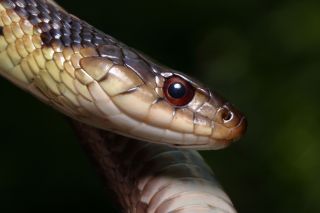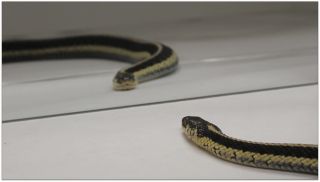Animal Behavior
Snakes, Self-Recognition, and Sociality
One snake species passes a test of self-recognition, but another fails.
Posted April 11, 2024 Reviewed by Ray Parker
Key points
- Scientists conducted an olfactory version of the mirror self-recognition test with two species of snakes.
- Garter snakes, but not ball pythons, showed evidence of self-recognition.
- An animal’s sociality or other aspects of its ecology may influence the capacity for self-recognition.

Since the 1970s, scientists have put a range of species in front of mirrors and recorded their reactions. They still can’t agree upon what the results mean.
The standard test of self-recognition involves painting a mark on an animal somewhere visible only in a mirror, such as its forehead. If the animal uses the mirror to investigate the mark on its body, it suggests it knows the reflection is of itself and not some other animal.
The debate is over what mirror self-recognition might imply about an animal’s cognitive abilities. Some scientists have linked success on the mirror test to self-awareness, while others argue that it might not require a complex sense of self at all.
The list of animals that have passed the mirror test is small but confusing. Great apes tend to pass, and at least a few individual dolphins and elephants seem to recognize their reflections. But in addition to these big-brained species, cleaner fish, roosters, and manta rays show some evidence of mirror self-recognition.
One problem with the mirror test is that it is biased toward animals that are primarily visual. Dogs, for instance, fail the standard mirror test. But when presented with an olfactory self-recognition task, they pass (investigating their own urine odor more when it is chemically “marked” with another scent).
Scientists at Wilfrid Laurier University in Ontario, Canada, adapted this paradigm to test snakes, another animal that interacts with the world mainly through olfaction. They report opposite results in garter snakes and ball pythons, with implications for the ecology of self-recognition.
An Olfactory Mirror
.jpeg.jpg?itok=c176DhlN)
The scientists tested two species of snakes with very different lifestyles. Eastern garter snakes are active, hunt insects and fish, and aggregate with others of their kind during mating season and for long winter naps. Ball pythons, on the other hand, are largely solitary and sedentary snakes that ambush their prey (primarily rodents).
But both snakes have oils in their skins that they leave on the ground as they slither along. The scientists rubbed makeup removal pads along the underside of the snakes to collect their scents. Then, they tested the snakes individually by placing them in a long, narrow box containing pairs of scented pads.
Each snake was presented with different combinations of five conditions:
- The snake’s own scent
- The snake’s own scent with an olive oil “mark” added
- The olive oil mark on its own
- The scent of another familiar snake
- The scent of another familiar snake with olive oil added
The team measured the snakes’ interest by recording how much time they spent close to each scent pad, as well as by counting their tongue flicks.
“One nice thing about snakes is that they smell by flicking their tongues out,” says Noam Miller, head of the Collective Cognition Lab at Wilfrid Laurier University and one of the study’s authors. They perform both long and short tongue flicks, with longer tongue flicks indicating more interest in whatever they are exploring.”

Miller and colleagues found that garter snakes performed more long tongue flicks in response to their own modified scent than to their own scent without an added mark. Garter snakes also investigated their own modified scent more than the olive oil alone or the marked scent of another snake.
“These results suggest to us that garter snakes are able to recognize their own scent and tell when it has been changed somehow,” says Miller.
In contrast, ball pythons responded similarly to all the scented pads.
“These two snakes have very different ecologies, which will have shaped how their cognition and behavior works,” says Miller. “We don’t know if the pythons are unable to differentiate between these different odors or if they just aren’t motivated to investigate one more than the other.”
Snakes’ Sense of Self
According to Miller, two things have been missing from discussions of self-recognition tests. The first is an understanding of the ecology of the species under study. In the case of these two snakes, the more gregarious species (garter snakes) showed self-recognition, while the less social species (ball pythons) did not. The ability to distinguish oneself from others may be tied to sociality. Or perhaps self-recognition is just easier to observe in social species, who might be more motivated to interact with mirrors or scents.
Miller says the animal self-recognition literature also lacks a discussion of the cognitive mechanisms that drive the behavior.
“Once you have a positive result on a test of self-recognition, what does that mean?” he says. “There have been claims that passing self-recognition tests means that one is conscious or self-aware or has a concept of self. I think that may certainly be true for a lot of animals. But I don't think that passing this test is strong evidence of that.”

The researchers say that there are many potential mechanisms, some fairly simple, that could enable an animal to pass a self-recognition test. Explanations range from simply knowing the difference between self and not-self all the way up to possessing self-awareness. Designing more specific experiments to test these explanations may tell us more about self-recognition than just repeating the mirror test with different species. And with over 5,000 species of snakes out there living diverse lifestyles, these reptiles offer opportunities to study which aspects of an animal’s ecology might drive the evolution of self-recognition.
Miller admits that there are some “not great” stereotypes about reptiles, particularly snakes. “Even within the scientific community, there is a bias toward thinking that reptiles are slow, sluggish, and instinctive and that they are not cognitively sophisticated,” he says.
“A lot of my research, including this paper, is geared toward overcoming that bias because it is definitely not true.”
References
Freiburger T, Miller N, and Skinner M. 2024. Olfactory self-recognition in two species of snake. Proc. R. Soc. B. 291: 20240125. Doi: 10.1098/rspb.2024.0125.




